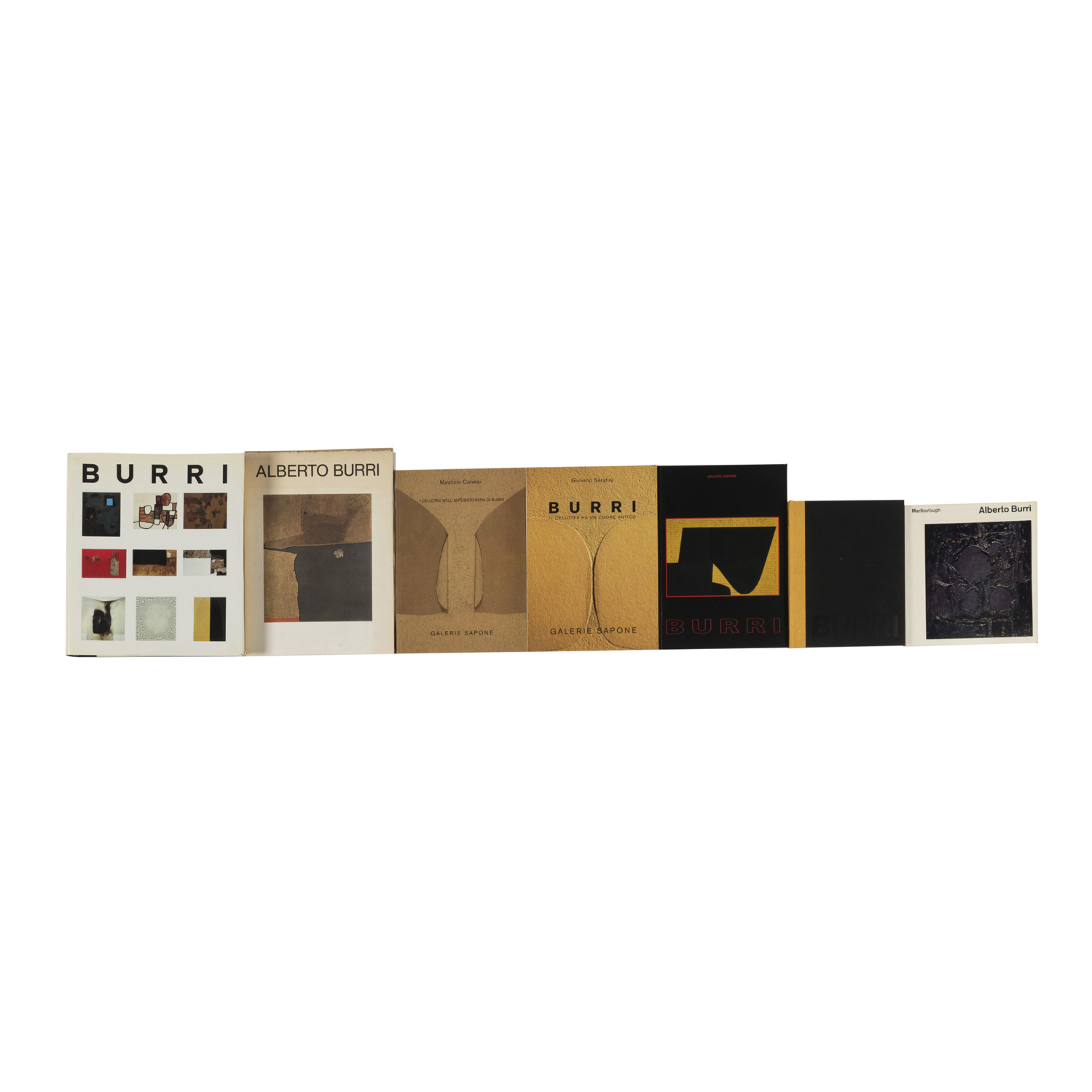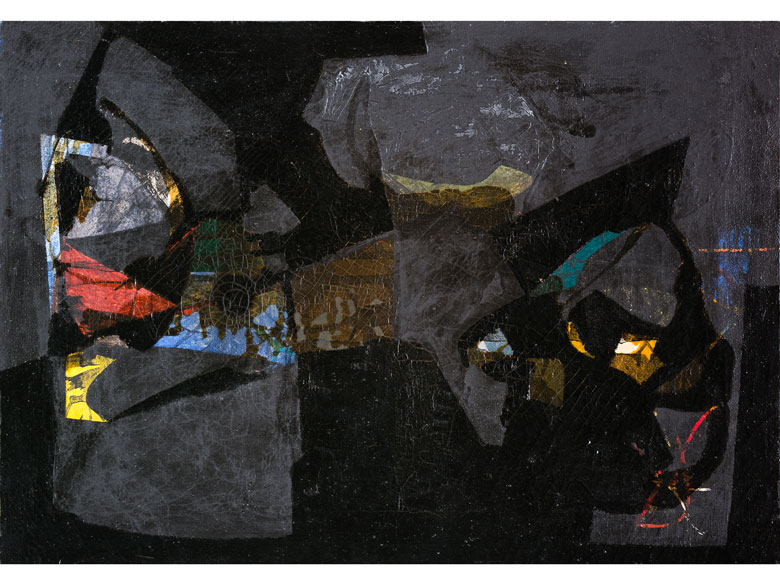12 Property of a Distinguished European Family Collection Alberto Burri Legno 1959 oil and wood collage on canvas 50 x 100 cm (19 5/8 x 39 3/8 in.) signed and dated 'Burri 59' on the reverse.
Provenance Acquired directly from the artist by the father of the present owner, 1960s Exhibited Francavilla al Mare, Fondazione F.P. Michetti, XXIII Mostra d’arte contemporanea, 8 July–5 September 1969 Literature N. Sarteanesi, Burri. Contributi al catalogo sistematico, Città di Castello: Fondazione Palazzo Albizzini, 1990, pp. 142-143, no.593 (illustrated in colour) Catalogue Essay In Alberto Burri's Legno, a vibrant rectangle of luscious crimson is starkly juxtaposed, and contrasted, with the warm, organic sensuality of fragments of wood; each filled with, and glorying, in its innate ornamentation. Executed in 1959, this seminal work belongs to Burri's series of Legni: wood-based works that emerged following his previous Sacchi. Where the tattered, rough-hewn sackcloth of those earlier works had spoken of certain threads of poverty – be they personal, artistic or intellectual – engaging the viewer with the drudgery of repetitive labour, as well as asking of them to reconsider their calibration of the hierarchy of media and, by extension, the manner in which they looked at, and appreciated, visual art, the Legni saw Burri turn to modern construction materials. Now, instead of reviving scraps of material by sewing them together, the artist transformed the found strips of wood by destroying or defacing them, and, in some cases, even burning it. Thus Burri’s visual vocabulary became more complex; continuing to employ the simplest of ‘matter’, but now directly confronting it and re-shaping its form (and meaning) directly on to his supports. The importance of Burri's art was recently celebrated in a major retrospective at the Solomon R. Guggenheim Museum, New York. This exhibition clearly catalogues the changes Burri affected to a panoply of different materials, all inextricably linked to his own idiosyncratic creative enterprise – wood, Cellotex, burlap, plastic, to name but a few. It is Burri’s intense exploration of these different materials, and the elemental changes he made to them, that allowed him to challenges their trajectories of history and meaning, and our appreciation of them. This practice, of course, would go on to influence a whole generation of artists, notably the ‘Arte Povera’ artists, such as Mario Merz who would create achingly beautiful works, grounded in the simplest of materials but enlivened through the most poetic and inventive of (meta)physical transformations. Burri, along with artists such as Robert Rauschenberg allowed both media and process to come together and speak vigorously of a new language of art. Subject and object thus became one and the same To create the Legni, Burri tended to use new wood veneers. These thin laminates of birch or oak were the quintessence of industrial mass production during Italy's post-war economic boom. In many of the earlier Legni, Burri would scorch sheets of veneer, creating a charred chiaroscuro on their surface. He then used Vinavil to glue the veneer onto canvas and also to seal the entire surface with a glossy finish. As the series advanced, the artist developed and refined his technique. The present work belongs to the subset of Legni with no evidence of burning. Instead, it is characterised by a smoother surface and a more balanced alternation of paint and wood. Amongst Burri’s oeuvre, the Legni show the strongest tension between the artist's visual delight, in colour, surface and structure, and his tight intellectual rigour; the object always serving the strong conceptual thrust of his ideas. Burri began painting when he was a prisoner of war in Texas, having been captured while serving as a doctor in the Italian army. While confined in the camp, painting suggested itself to him as substitute to ‘action’, eventually becoming an action in its own right-- a catharsis in which past and present, art and life, became one. For Burri, art remained an analogue to the healing of his original vocation, as he transformed and revived his materials. In his subversive in
12 Property of a Distinguished European Family Collection Alberto Burri Legno 1959 oil and wood collage on canvas 50 x 100 cm (19 5/8 x 39 3/8 in.) signed and dated 'Burri 59' on the reverse.
Provenance Acquired directly from the artist by the father of the present owner, 1960s Exhibited Francavilla al Mare, Fondazione F.P. Michetti, XXIII Mostra d’arte contemporanea, 8 July–5 September 1969 Literature N. Sarteanesi, Burri. Contributi al catalogo sistematico, Città di Castello: Fondazione Palazzo Albizzini, 1990, pp. 142-143, no.593 (illustrated in colour) Catalogue Essay In Alberto Burri's Legno, a vibrant rectangle of luscious crimson is starkly juxtaposed, and contrasted, with the warm, organic sensuality of fragments of wood; each filled with, and glorying, in its innate ornamentation. Executed in 1959, this seminal work belongs to Burri's series of Legni: wood-based works that emerged following his previous Sacchi. Where the tattered, rough-hewn sackcloth of those earlier works had spoken of certain threads of poverty – be they personal, artistic or intellectual – engaging the viewer with the drudgery of repetitive labour, as well as asking of them to reconsider their calibration of the hierarchy of media and, by extension, the manner in which they looked at, and appreciated, visual art, the Legni saw Burri turn to modern construction materials. Now, instead of reviving scraps of material by sewing them together, the artist transformed the found strips of wood by destroying or defacing them, and, in some cases, even burning it. Thus Burri’s visual vocabulary became more complex; continuing to employ the simplest of ‘matter’, but now directly confronting it and re-shaping its form (and meaning) directly on to his supports. The importance of Burri's art was recently celebrated in a major retrospective at the Solomon R. Guggenheim Museum, New York. This exhibition clearly catalogues the changes Burri affected to a panoply of different materials, all inextricably linked to his own idiosyncratic creative enterprise – wood, Cellotex, burlap, plastic, to name but a few. It is Burri’s intense exploration of these different materials, and the elemental changes he made to them, that allowed him to challenges their trajectories of history and meaning, and our appreciation of them. This practice, of course, would go on to influence a whole generation of artists, notably the ‘Arte Povera’ artists, such as Mario Merz who would create achingly beautiful works, grounded in the simplest of materials but enlivened through the most poetic and inventive of (meta)physical transformations. Burri, along with artists such as Robert Rauschenberg allowed both media and process to come together and speak vigorously of a new language of art. Subject and object thus became one and the same To create the Legni, Burri tended to use new wood veneers. These thin laminates of birch or oak were the quintessence of industrial mass production during Italy's post-war economic boom. In many of the earlier Legni, Burri would scorch sheets of veneer, creating a charred chiaroscuro on their surface. He then used Vinavil to glue the veneer onto canvas and also to seal the entire surface with a glossy finish. As the series advanced, the artist developed and refined his technique. The present work belongs to the subset of Legni with no evidence of burning. Instead, it is characterised by a smoother surface and a more balanced alternation of paint and wood. Amongst Burri’s oeuvre, the Legni show the strongest tension between the artist's visual delight, in colour, surface and structure, and his tight intellectual rigour; the object always serving the strong conceptual thrust of his ideas. Burri began painting when he was a prisoner of war in Texas, having been captured while serving as a doctor in the Italian army. While confined in the camp, painting suggested itself to him as substitute to ‘action’, eventually becoming an action in its own right-- a catharsis in which past and present, art and life, became one. For Burri, art remained an analogue to the healing of his original vocation, as he transformed and revived his materials. In his subversive in
.jpg)
_piccola_serigrafia_1981_15_firm_d5566180g.jpg)



.jpg)








Testen Sie LotSearch und seine Premium-Features 7 Tage - ohne Kosten!
Lassen Sie sich automatisch über neue Objekte in kommenden Auktionen benachrichtigen.
Suchauftrag anlegen